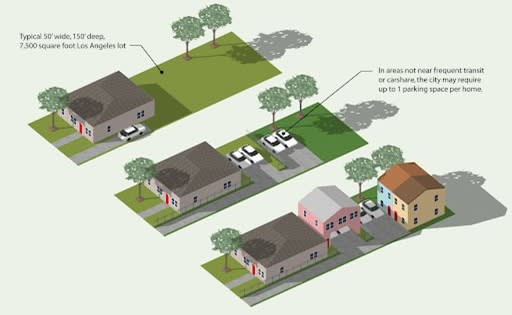Senate Bill 9, which took effect Jan. 1, 2022, will make it easier for Californians to build more than one housing unit on many properties that for decades have been reserved exclusively for single-family homes and will give cities greater flexibility to place small apartment complexes in neighborhoods near public transit.
What is Senate Bill 9?
- It allows property owners to split a single-family lot into two lots, add a second home to their lot or split their lot into two and place duplexes on each.
- The last option would create four housing units on a property currently limited to a single-family house.
- The new law will mark a shift from current policies that allow a stand-alone house and an accessory dwelling unit, as well as an attached junior unit no larger than 500 square feet.
- Under the new law, cities and counties across California will be required to approve development proposals that meet specified size and design standards.
Can you do this?
- Homeowners or landlords can apply to upzone their properties through their local jurisdiction, but only if they plan to live on the property for a while.
- Property owners must sign an affidavit stating they will occupy one of the housing units as their primary residence for at least three years after splitting their property or adding additional units.
What are the caveats?
- The law is designed to create additional housing while also preserving low-income, affordable units.
- A proposed project under this new law cannot result in the demolition or alteration of affordable or rent-controlled housing or market-rate housing that has been occupied by a tenant in the past three years. Properties listed as historic landmarks or those located within a historic district are off-limits for new development. Wetlands, farmland and properties at high risk of fire or flooding are also exempt.
- If someone chooses to split their property in two, each new lot must be at least 1,200 square feet, according to the new law.
- Any unit created as a result of the law cannot be used for short-term rentals. They must be rented for a term longer than 30 days.
How much of an impact will SB9 have?
- According to the Terner Center, 5.4% of 7.5 million existing single-family parcels in California have SB9 potential.
- If built to maximum feasibility, this would create approximately 700,000 new housing units.
- Whether additional supply will reduce prices is an interesting question. Residential real estate values are based on both the value of the land and the value of the building. SB9 makes land more valuable since two buildable lots are worth more than one. No one can say exactly how much more since larger lots are worth more than smaller lots. Nor can anyone predict whether properties in “densified” neighborhoods will generally decline in value due to perceived crowding.
What about potential buyers?
- Units with less associated land should be less expensive and more affordable than existing units with more land.
- On the other hand, SB9 sets up a dynamic where those who do not want to split a lot or add a second unit on an existing lot must compete against buyers who are willing to develop. Those who prefer more space may find prices even further out of reach.
- Ultimately, the effect on affordability may depend on the speed of any market adjustment. If buyers pay extra for development potential faster than prices fall due to actual development, housing will become less affordable. If the opposite occurs, affordability will improve.
Credit: Alfred Twu
In areas not near frequent transit or carshare, cities may require parking. However, lots in these areas are usually larger. As a workaround, you can rent your driveway to a carshare company.
Credit: Alfred Twu
Even if you can't split the lot due to the existing house taking up most of the land, you can still build a 2nd home now and split the lot later.
Credit: Alfred Twu
Another option is to build Accessory Dwelling Units instead of regular homes. These are smaller, but you can get to 4 homes this way without doing a lot split.
Credit: Alfred Twu
References:






